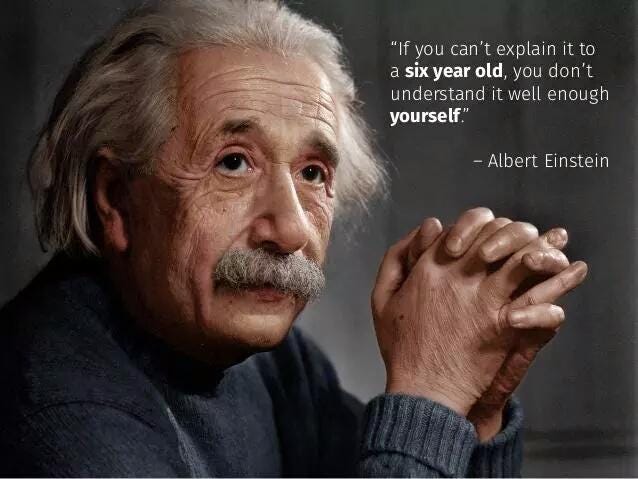Managing cognitive biases as a newly qualified physiotherapist
Thanks for reading the 6th edition of my newsletter. This newsletter tracks my work to create the best available resource for newly qualified physiotherapist interested in MSK.
I was notified by LinkedIn that it was my 3rd working anniversary, which meant that I have spent close to 36 months consulting and treating patients mainly in an MSK setting. Working across diverse areas (sports, NHS, private) and regions (Leeds, Airedale, Lincoln, Central London) has exposed me to a wide variety of patients. One fortunate aspect of my journey has been the opportunity to collaborate with bright-minded clinicians who often leave me in awe of their depth of knowledge. Sometimes they just make you think, how do they know all of that?!
I started to think about what I could do to reach their levels of expertise. All the top-notch clinicians seem to share the same quality
The ability to think clearly
Thinking clearly means being able to prioritise information, rationalise the context in which information is presented, connect information, and apply it to reach a conclusion, all while managing external stressors.
But there's more to it.
Top clinicians also excel in reducing Cognitive Biases. Cognitive biases are patterns of thinking errors resulting from mental shortcuts and emotional factors, which can lead to judgment and perception errors. These biases affect various human behaviours, including decision-making and problem-solving. Cognitive biases come in many forms and are studied in fields like psychology and economics to understand their impact on human decisions.
I decided to delve deeper into these biases. Here are a few that I found relevant to my practice and have made a huge effort to eliminate.
Confirmation Bias
Meet my friend, an unwavering Apple enthusiast. He's the proud owner of everything from the latest iPhone to a magical mouse. He passionately extols the virtues of Apple products and the genius of Steve Jobs. He even invests substantial sums to attend Apple conferences. Recently, he shared that he had a falling out with another friend who dared to suggest, "Apple products are a massive waste of money.”
In this case, my friend's confirmation bias is evident. He actively seeks and gives more weight to information aligning with his existing beliefs while downplaying or ignoring contradictory information. This bias influences his perception of Apple's superiority, blinding him to alternative options or viewpoints.
Why does it matter to you as a physio:
You've likely encountered individuals fervently advocating passive treatments like massage, dry needling, and ultrasound. They invest considerable money in these treatments, unsure of their efficacy. If you disagree during the first consultation, you may find yourself in their bad books, jeopardizing the therapeutic alliance. Use their confirmation bias to your advantage by gradually introducing the importance of active treatment over time.
Spark Effect
Suppose you want to sign up to buy a product online. When you open a page to register you have two options:
A short and straightforward form that only asks for your email address.
A longer form that asks for your name, email address, phone number, and other details.
You are more likely to choose the first option (a short and straightforward form) because it appears to be the easier and quicker option. The second option, while it might provide more information, creates more friction and is less attractive to you, especially if you are not yet fully committed to the website.
Why does it matter to you as a physio:
Suppose you want to encourage a patient to become more active. Start small! Don't overwhelm them with a list of ten different exercises if they have some history of physical activity. Even one simple exercise can kickstart their journey. Reducing friction and presenting actions as small or straightforward increases engagement and the likelihood of them taking the desired steps.
Occam’s Razor
Suppose you're in a park, and you see a tree with its leaves and branches moving. You have two possible explanations for the tree's movement:
There is a strong wind blowing, which is causing the tree to sway.
The tree is moving because it's inhabited by invisible, mischievous forest spirits who are shaking it.
Occam's Razor would recommend you favor the first explanation: the wind is causing the tree to sway. This is the more straightforward explanation, as it aligns with your everyday experience of how trees respond to wind. The second explanation introduces complex and unlikely elements like invisible forest spirits, which are not necessary to explain the observed phenomenon. In essence:
The simplest explanation is usually the best.
Why does it matter to you as a physio:
When I first explained the diagnosis to patients, I would go into minute details: the complex anatomy, the pathophysiology, complex pain explanation only to realise that patients don’t really care that much. Simplicity is key. Your patients often want the basics: What is it? Will it improve? How can they contribute to their recovery? Avoid overwhelming them with complex anatomical details and pathophysiology. Instead, provide straightforward explanations and offer more in-depth information if they express interest.
Curse of Knowledge
The Curse of Knowledge is a cognitive bias that occurs when a person, who is knowledgeable about a particular topic or subject, assumes that others have the same level of understanding and familiarity with that topic. This assumption can lead to difficulties in communication and teaching, as the knowledgeable person may inadvertently use jargon, complex language, or concepts that the audience does not understand.
Why does it matter to you as a physio:
Threading along similar lines as Occam’s Razor, don’t overcomplicate things! When explaining complex ideas, remember to break them down into simple, clear, and accessible terms. Understand that not every patient shares your knowledge, and effective communication involves bridging the knowledge gap with clear, relatable explanations.
I really enjoyed the below series as they ask experts in different fields to explain in 5 levels of difficulty. You might like this one:
Streisand Effect
The Streisand Effect typically happens when someone tries to suppress information or content. Instead of making the information disappear, these efforts often result in a surge of interest, increased visibility, and wider dissemination of the content. This happens because people become curious about what is being hidden, and they share and discuss it more, making it even more prominent.
Why does it matter to you as a physio:
When I first started seeing patients, I would shy away from discussing MRIs, injections, and surgery with patients, thinking that if I didn’t mention it they wouldn’t notice. However, I often realise that patients became more curious and asked about it even more! So, don't shy away from discussing diagnostic tools, interventions, or surgeries with your patients. Patients appreciate your straightforward approach and trust in your expertise.
Law of the Instrument
If all you have is a hammer, everything looks like a nail
It is a cognitive bias or concept that suggests that people tend to rely on familiar tools or methods, even when they might not be the most suitable for a given situation. This tendency can result in suboptimal or inappropriate solutions to problems.
Why does it matter to you as a physio:
There will be one point where you start to see patients with a similar pathology: OA, RCRSP, and Low back pain. It is very easy to use a blanket approach to manage these patients: education, activity modification, and exercise. But no one human is the same. Be open to considering alternative tools or approaches and avoid overusing a particular method or tool simply because it is the one we are most familiar with. It encourages a more flexible and adaptive mindset in problem-solving and decision-making.
The Semmelweis Reflex
Ignaz Semmelweis is a Hungarian physician who made a significant discovery in the mid-19th century. He worked at the Vienna General Hospital, where there were two maternity clinics: one staffed by doctors and medical students and the other by midwives. Semmelweis noticed a striking difference in mortality rates between the two clinics. The clinic staffed by doctors had a much higher maternal mortality rate compared to the clinic staffed by midwives.
Semmelweis conducted investigations and realised that doctors frequently went from performing autopsies to delivering babies without proper hand hygiene.
Semmelweis instituted a policy of handwashing with chlorinated lime solutions for the doctors and medical students, an idea that seems sensible retrospectively. However, when he initially proposed his findings, he faced significant resistance from the medical community.
The Semmelweis Reflex came into play when the medical establishment rejected his groundbreaking idea. Many doctors and colleagues were unwilling to accept the implications of Semmelweis's findings. They rejected the notion that their own actions could be causing harm to their patients. They were resistant to the idea of handwashing because it challenged the established medical practices and beliefs of the time. an idea that sounds ridiculous in today's medical world.
Why does it matter to you as a physio:
Medicine is ever-evolving. Embrace new evidence and apply it, even if it contradicts established norms or beliefs. Adapt to the changing landscape of healthcare to provide the best care for your patients. Who would have thought that exercise was a great form of treatment for low back pain in the early 80s instead of bed rest?
Thank you for reading through this edition. I hope you've found value in the exploration of cognitive biases and their relevance to your work as a physiotherapist. If you enjoyed this piece, please consider sharing it with your colleagues and peers. Stay tuned for more insightful content in the next edition.
See you next time,
Justin



